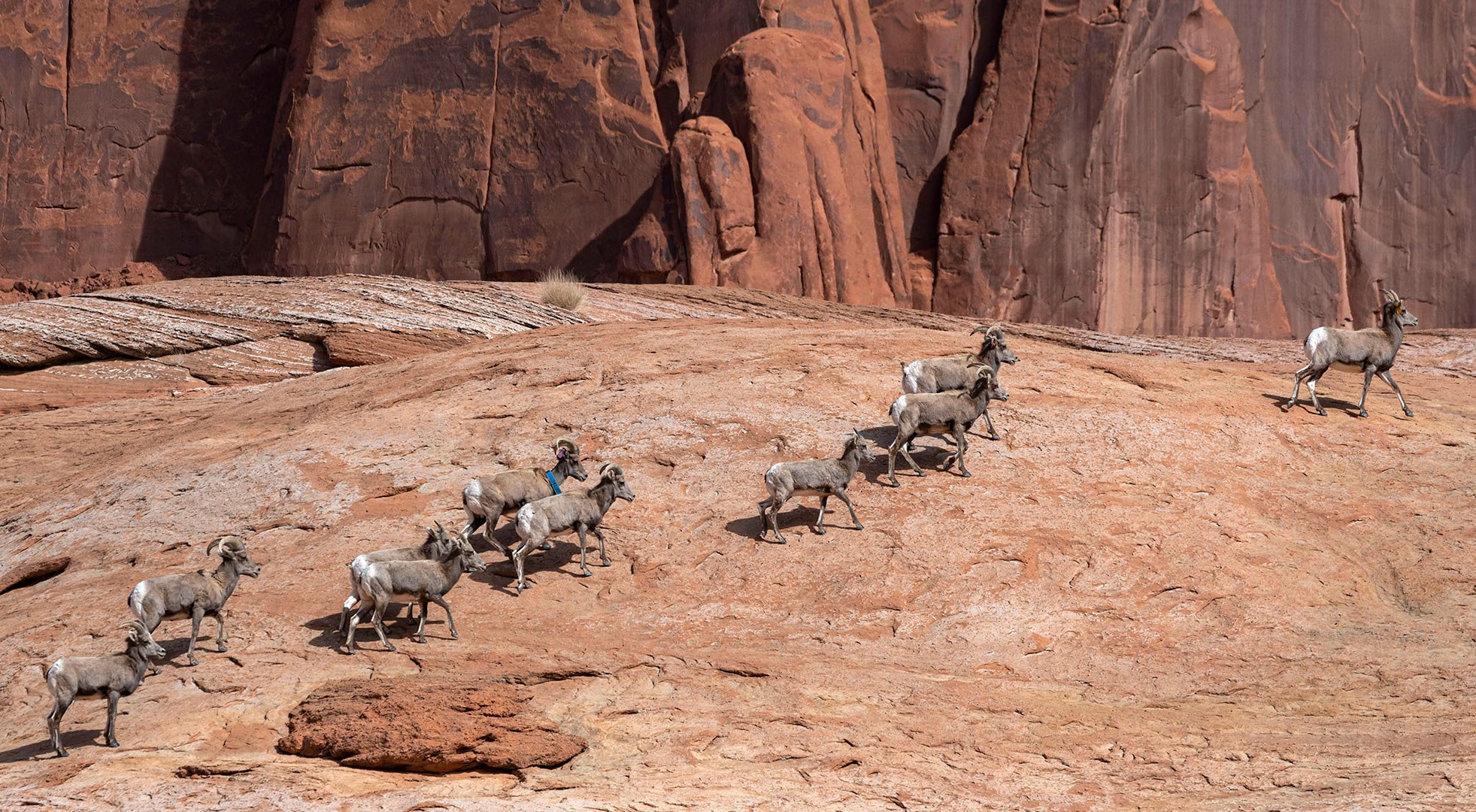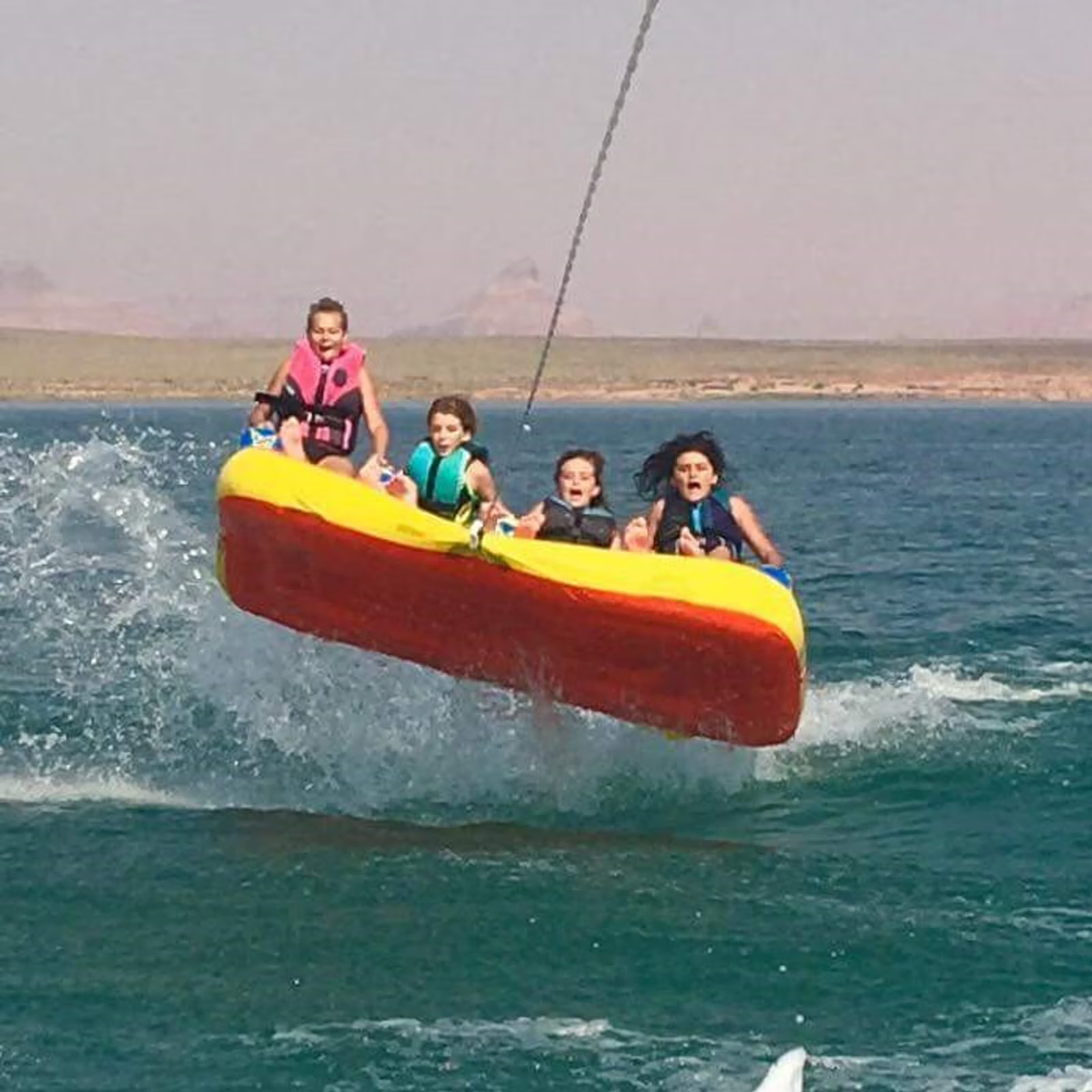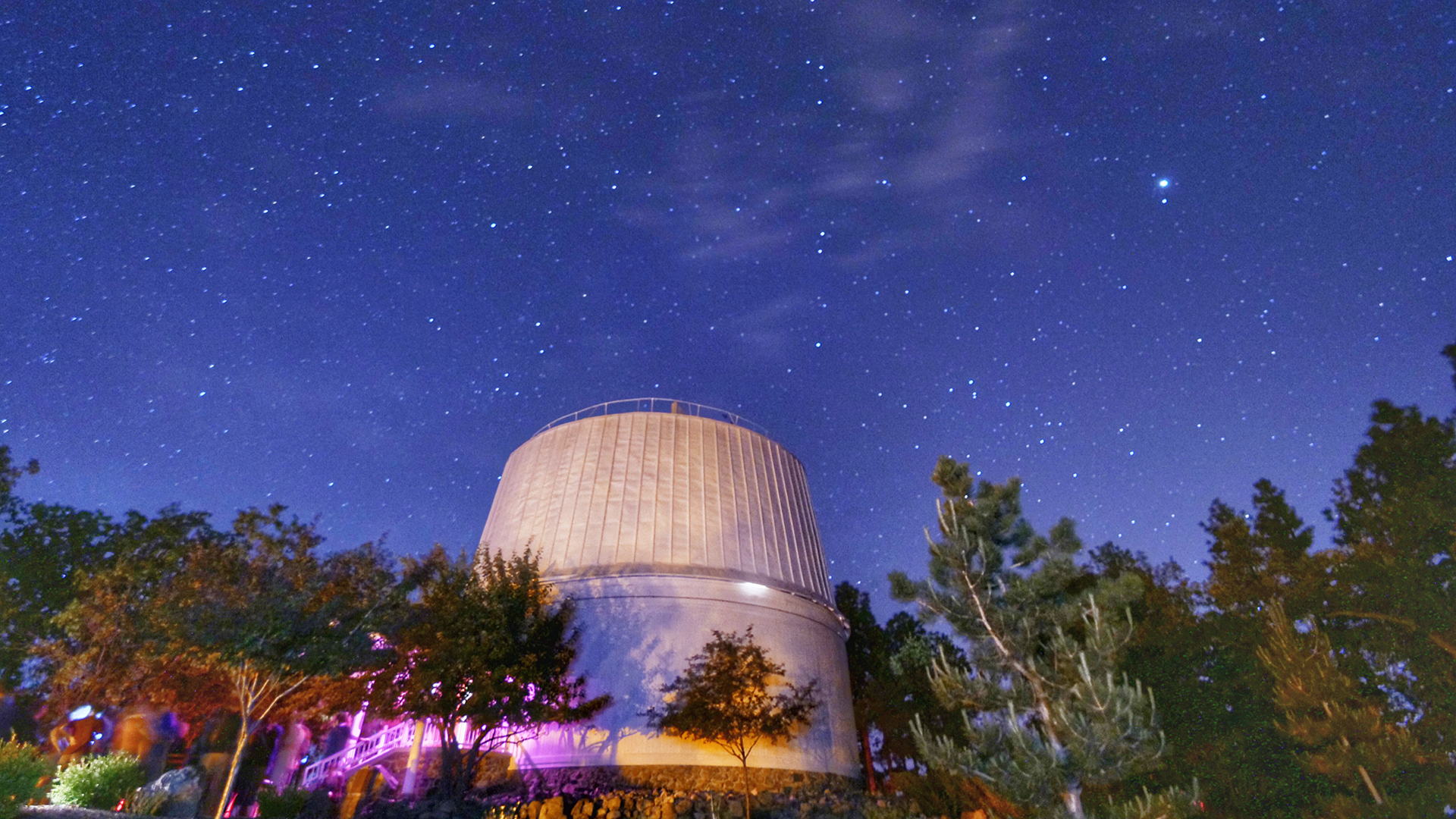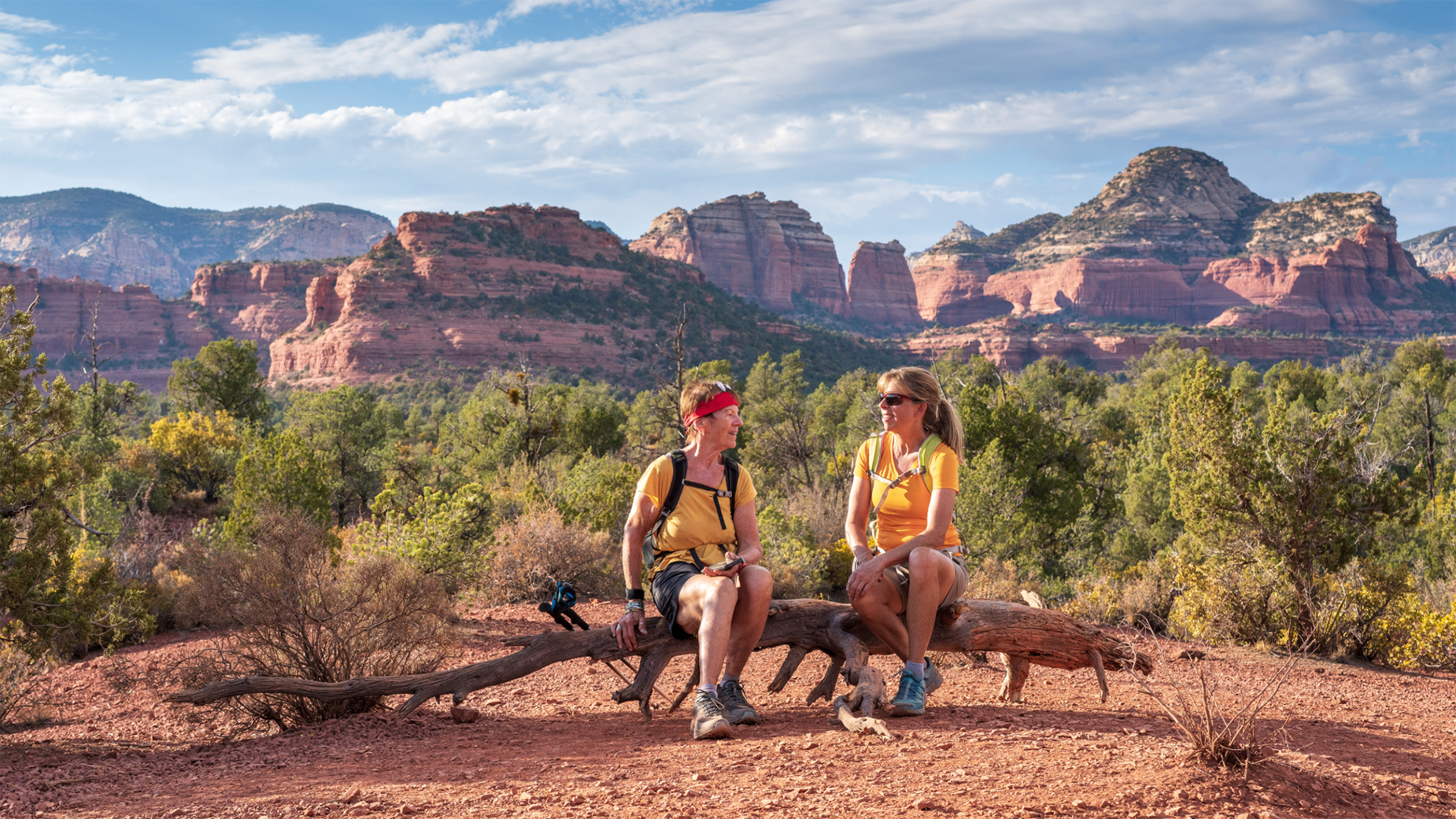The Way it Was
How did Glen Canyon get its name? John Wesley Powell, in addition to being a geologist and geographer of note, was a colorful and perceptive writer, with almost photographic powers of description. As his ragtag first-ever expedition entered this riparian canyon complex in late July 1869, he and his men marveled at the "curious, narrow glens." In Powell's book Exploration of the Colorado River and its Canyons, (1895), he describes Glen Canyon as a -curious ensemble of wonderful features—carved walls, royal arches, glens, alcove gulches, mounds and monuments. From which of these features shall we select a name? We decide to call it Glen Canyon".
The Way it Is
Climatologists have stated that our current dry period is actually a megadrought, exceeding the long drought that in the early 1200s is believed to have uprooted native tribes and cultures throughout the Southwest. Snowfall on the western slope of the Rockies feeds Lake Powell, and as is well-known, higher temps and less precipitation since 2000 have drawn down both Powell and Lake Mead, changing the recreational options on both lakes. The last time Lake Powell was this low was late November of 1967, when the lake was first filling. Yet, there may be a silver lining to our great Southwestern drought, at least for those who thirst for adventure.
Page is the Gateway
Page is the place to begin your personal odyssey, with full services and currently the only powerboat rentals on this great lake. In search of that elusive silver lining, in mid-February of 2022, I rented a 22' pontoon boat from Lake Powell Vacations in Page, stuffed it with camping and photo gear, and set off from Wahweap Marina on a mission of discovery.
My chief goal was to see what sights have reappeared as the lake level dropped to 170' below full pool, and perhaps walk in the virtual footsteps of John Wesley Powell and his intrepid crew. They traversed Glen Canyon's 169.6-mile length twice, in 1869 and 1871, marveling at its features and leaving place names that hint at the beauty that was drowned after 1963.
Life Finds a Way
You can still rent and run a houseboat on Lake Powell, but truly roaming the lake's hidden glories requires a rugged powerboat that can tie up on a sandy/rocky shoreline and enter narrow sinuous chasms. While I truly love the houseboat experience on Lake Powell, savoring them as luxurious wilderness base camps, sometimes roughing it is the best way to take the measure of yourself in a wild landscape. And make no mistake, this is reverting to the old ways. My two rugged friends beach camped with me for three cold nights, sleeping without tents under a huge waxing moon.
Is life returning to what was once Glen Canyon? The steadily dropping water level should allow new plant growth on open soil as the weather warms. But on this winter quest it is the animal life that I find striking. I've never seen so many birds on these waters, as flocks of ducks and other small waterfowl flourish in many of the side canyons we ease into on our search. For the first time ever on Lake Powell, I see a striking Bald Eagle soaring over the main channel. He alights on a pillar of striped sandstone near Mile 65, in solitary splendor, watching us from 100' above. I take it as an omen of better days ahead.
Cruising Wetherill Canyon at Mile 40, we step out on sandstone shelves that have been in wet darkness for five decades, to stretch our legs. Sharp-eyed Jeff calls out softly and points north, to a herd of ten very healthy desert bighorn sheep running on the high sandstone. These are the first bighorns I've seen at Lake Powell in nearly forty years of visits. Perhaps the low-water fears are keeping humans away, as we see not a soul the first two days out and less than a handful after that.

Something I quickly learned to watch for was the caves incised into the sheer sandstone walls, which now are open grottos to explore by small boat or even better, by kayak. I found remarkable dazzling light shows in several of these deeper ‘sea caves,’ as the low winter sun angled inside and bounced reflected light rays off the cold clear waters onto the sculpted ceilings. We drive the boat to the entrances of these caves and glide slowly inside, motor off, entranced by the dancing light spectacle. The first grotto we found is in Rock Creek Bay, (Mile 36), just a couple of miles from the mouth and in a cove off to the right. It appears first as a dark triangle, until you near the entrance and realize it continues inside the cliff some 30-40 yards. I’ll gladly kayak it when warm weather returns.
Across that very cove is a rare ceiling arch of great beauty, framing the sky. We cruised in below the arch some 220’ above us, and I recalled a September day in 2020 when the lake was far higher and I literally squeezed into the space below the arch by lying flat on my back in the kayak. On that day it was like entering a cenote, ethereal and solemn, but now that previous watery plane is 150’ over our heads. Change comes dramatically in canyon country!
Two other grottos of note are in Driftwood Canyon (Mile 46) and Reflection Canyon (Mile 56). I study these ‘Gifts of Low Water’ and wonder if perhaps just below them a Native American structure might be found? If the lake continues its steady decline, one year soon I may find the answers.
So where does the Colorado River end, flowing south from Cataract Canyon in Canyonlands National Park, and Lake Powell begin? This was one of my goals, to find this line of demarcation, but the scarcity of fuel and a bent prop kept me from venturing north of Bullfrog Marina in Bullfrog Bay (Mile 95) on this trip. I would hazard a guess that the river shows a ‘pulse’ or current somewhere below Hite Marina, roughly 130 miles from the dam at Mile 0. Should the drought continue until the lake drops officially to Dead Pool, when water can no longer be released from Glen Canyon Dam, the real river should be noticeable much further south. This is akin to a real-time geology/hydrology experiment, written on a titanic scale. For now, everywhere you turn is the horrid bathtub ring, the stigmata of drought …

Rebirth
My very favorite place to venture into on all my prior Lake Powell trips is a space of true reverence, Cathedral in the Desert. It’s never been easy or fast to reach, being some 69 miles up lake from the dam, (Mile 0 on your map), tucked into a side canyon of the Escalante River tributary arm. This was a primary goal for me, more of a pilgrimage really, to learn if we could find our way in and see if the formerly flooded chasm is, at last, high and dry?
Two canyons in from the mouth of the Escalante we turn left, south, into Clear Creek Canyon. Not a soul in sight, just near-perfect mirror reflections of the cream-hued bathtub ring, topped by the ocher ramparts and sheer cliffs stained with tapestries of desert varnish. Slowing, round the bend we spy a drowned forest, remarkably preserved but a spectral hazard we must pass through. Gray and black trunks seem to reach out for our boat, rotting casualties of the dam days of the 60s. It’s like entering a vertical graveyard and Captain Jay skillfully picks his line through the trees, as Jeff and I watch for hazards in the now very muddy waters. A brown wet bank appears around a final bend. Rivulets of clear water run off a dark watery sandbar into the last navigable feet of this canyon where once I cruised at speed into the sweeping alcove known as Cathedral in the Desert.
Jay aims the boat for a soft-edged bank of wet muddy sand, kills the motor and pulls the prop, as we are just a few feet above bottom. Silence prevails. Slogging across a deep layer of sediment is not for the faint of heart, but I finally wind my way around what I know to be the last bend I turn right into the great alcove and hear the teasing sounds of falling water. A dune of orange sand rises steeply to my right, filling half of the space, and the trickling waterfall I recall from years past is musically alluring … and much taller.
Cathedral in the Desert lives again! I ascend the dune while looking left to the wispy waterfall and shallow clear pool below. All is in open shade, and the revelatory vision of a reborn piece of Glen Canyon fills my eyes and heart with joy and wonder. Here at least, Glen Canyon is returning to life, water in the desert flowing freely, with only my heartbeat to compete with the sound of music, at the apex of a great cove. This is what I ventured here to discover, a hint of rebirth, as this ecosystem is healing before our eyes. I believe Ed Abbey would be very pleased.
Perils
At these low water levels, perils can sneak up very quickly, as did the sudden spire of sandstone in the Escalante Arm that bent our prop as we left Cathedral in the Desert. Two inches lower and we’d have been stranded with a broken engine, yet an inch or two higher and we’d have just missed it and never known how close we’d been to sheared metal. We’d been cruising in 220’ of water and abruptly we were in 3-4’, without warning. Always have a spotter in the bow and be ready to slow and lift your prop! The lesson is that the NPS has only marked some of the known older shoals, and it’s up to you to find the new perils. Cell service is quite limited on the lake, so don’t count on timely emergency assistance.
The Journey Home
Lake Powell has always had a roll call of wonders, but now there are new wonders to discover as you roam. Rainbow Bridge is currently far from the water’s edge, just as it was for thousands of years, and that distant afternoon I swam directly beneath it in the storied summer of ’83 now seems like a fever dream. So, it is possible, though highly unlikely, that when this great 20+ year megadrought breaks, that a succession of heavy snowy winters might again fill this, the largest reservoir in the continental United States. But until that fateful day, there is much to marvel over and walk and kayak and study and admire at low water, in the corridor of canyons traversed by J. W. Powell 150+ years ago.
America's Lost National Park?
Even now, at -170’ there are new beaches of soft sand to walk and bed for the night, under supremely dark skies. We camped on such a beach on our last night, in Padre Bay with landmark Cookie Jar Butte just north. A nearly full moon was our nightlight from dusk to pre-dawn, as the minimal lights of Page dotted a sliver of horizon twenty miles to the south, as the raven flies…
Tips & Planning
- Buy as your best/first map ‘Lake Powell and Its 96 Canyons~Boating & Exploring Map’
- You can rent pontoon boats and powerboats at from Lake Powell Vacations office in Page, or at Antelope Point Marina.
- Both the above are in Arizona, and both have fuel as well as kayak rentals. Note: Antelope Point Marina is on the Navajo Tribal lands and may been on a different time zone than yours.
- No boats are currently for rent at Bullfrog Marina (Mile 94+), but you can buy fuel here.
- Note: Dangling Rope Marina is still closed for repairs, meaning there is NO FUEL mid-lake. Be certain you top off your boat tank before leaving the marina and strongly consider carrying additional fuel in safe gas containers. I recommend 15-20 gallons as a reserve.
- Page has a fine range of motels and hotels, including several new properties. You can buy all your provisions in Page. They have a big Safeway and a Walmart, etc.
- Lake Powell is the heart of the Glen Canyon National Recreation Area, administered by the National Park Service. If you don’t have the NPS Annual Parks Pass, you will pay $35 at the gate.
- Track Lake Powell’s current water level at: https://lakepowell.water-data....
Resources
John Wesley Powell- The Exploration of the Colorado River and its Canyons’ (1895-in print)
Edward Abbey- ‘The Monkey Wrench Gang’ (1975-in print) https://www.desertusa.com/desert-people/edward-abbey.html
Eliot Porter- ‘The Place No One Knew’ (2000-special paperback edition)


Kerrick James
Kerrick James is a travel journalist specializing in active and cultural adventures worldwide, but Arizona is home. The 2020 SATW Travel Photographer of the Year, he’s rafted the Grand Canyon for magazine stories, to teach photo workshops, and purely for fun.

















